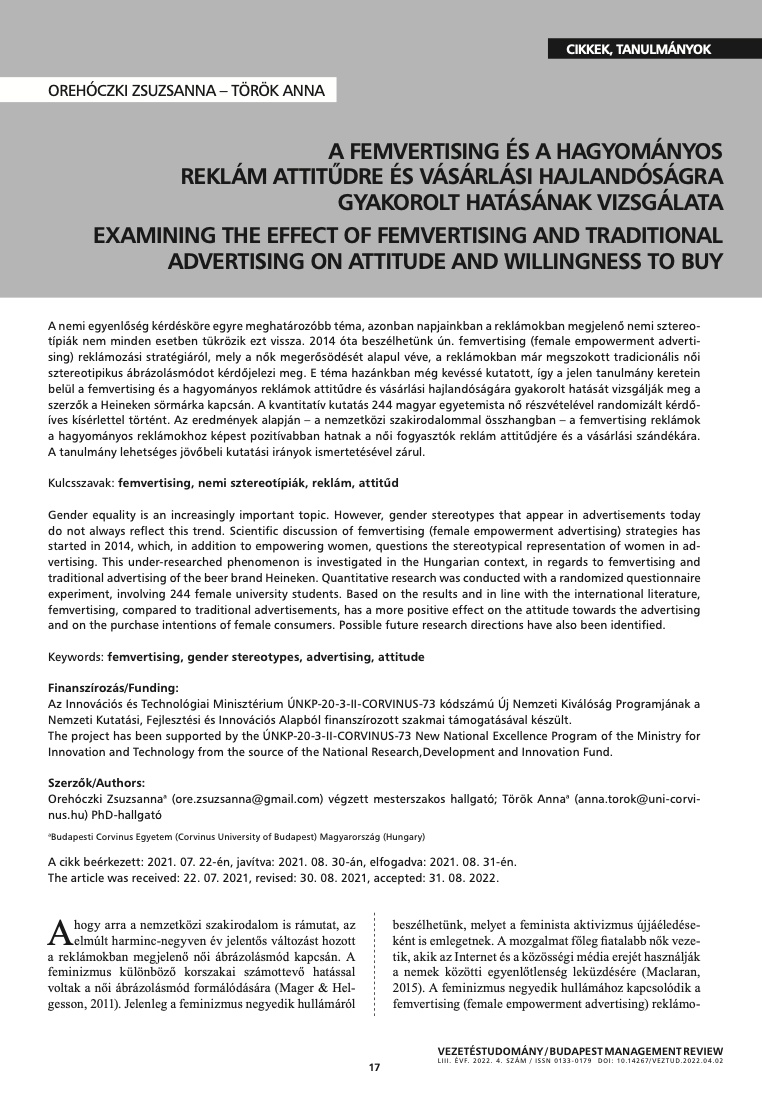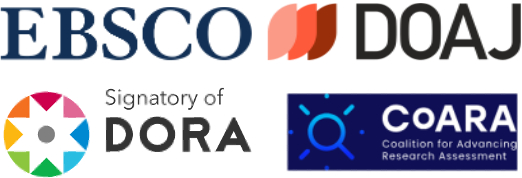A femvertising és a hagyományos reklám attitűdre és vásárlási hajlandóságra gyakorolt hatásának vizsgálata
DOI:
https://doi.org/10.14267/VEZTUD.2022.04.02Kulcsszavak:
femvertising, nemi sztereotípiák, reklám, attitűdAbsztrakt
A nemi egyenlőség kérdésköre egyre meghatározóbb téma, azonban napjainkban a reklámokban megjelenő nemi sztereotípiák nem minden esetben tükrözik ezt vissza. 2014 óta beszélhetünk ún. femvertising (female empowerment advertising) reklámozási stratégiáról, mely a nők megerősödését alapul véve, a reklámokban már megszokott tradicionális női sztereotipikus ábrázolásmódot kérdőjelezi meg. E téma hazánkban még kevéssé kutatott, így a jelen tanulmány keretein belül a femvertising és a hagyományos reklámok attitűdre és vásárlási hajlandóságára gyakorolt hatását vizsgálják meg a szerzők a Heineken sörmárka kapcsán. A kvantitatív kutatás 244 magyar egyetemista nő részvételével randomizált kérdőíves kísérlettel történt. Az eredmények alapján – a nemzetközi szakirodalommal összhangban – a femvertising reklámok a hagyományos reklámokhoz képest pozitívabban hatnak a női fogyasztók reklám attitűdjére és a vásárlási szándékára. A tanulmány lehetséges jövőbeli kutatási irányok ismertetésével zárul.
Letöltések
Hivatkozások
Abitbol, A., & Sternadori, M. (2019). Championing Women’s Empowerment as a Catalyst for Purchase Intentions: Testing the Mediating Roles of OPRs and Brand Loyalty in the Context of Femvertising. International Journal of Strategic Communication, 13(1), 22-41. https://doi.org/10.1080/1553118X.2018.1552963
Åkestam, N., Rosengren, S., & Dahlen, M. (2017). Advertising “like a girl”: Toward a better understanding of “femvertising” and its effects. Psychology & Marketing, 34(8), 795-806. https://doi.org/10.1002/mar.21023
Becker–Herby, E. (2016). The rise of femvertising: authentically reaching female consumers (Thesis). Minneapolis: University of Minnesota, School of Journalism and Mass Communication.
Bahadur, N. (2014). ‘Femvertising’ Ads Are Empowering Women — And Making Money For Brands [on- line]. Retrieved from https://www.huffpost.com/entry/femvertising-advertising-empowering-women_n_5921000
Bauer, A. (1996). A reklámhatás kutatásának fejlődése. Marketing & Menedzsment, 30(3), 65-69. https://journals.lib.pte.hu/index.php/mm/article/view/2437
Bergkvist, L., & Rossiter, J. R. (2007). The Predictive Validity of Multiple-Item Versus Single-Item Measures of the Same Constructs. Journal of Marketing Research, 44(2), 175–184. https://doi.org/10.1509/jmkr.44.2.175
Cannes Lions (2021). Glass: The Lion for Change [online]. Retrieved from https://www.canneslions.com/enter/awards/good/glass-the-lion-for-change#/
Chang, T.-Z., & Wildt, A. R. (1994). Price, Product Information, and Purchase Intention: An Empirical Study. Journal of the Academy of Marketing Science, 22(1), 16 –27. https://doi.org/10.1177/0092070394221002
Cornwall, A. (2016). Women’s empowerment: What works? Journal of International Development, 28(3), 342-359. https://doi.org/10.1002/jid.3210
Cortese, A. J. (2015). Provocateur: Images of women and minorities in advertising. Lanham: Rowman & Littlefield.
Drake, V. E. (2017). The impact of female empowerment in advertising (femvertising). Journal of Research in Marketing, 7(3), 593-599. https://doi.org/10.17722/JORM.V7I3.199
Ducoffe, R. H. (1995). How Consumers Assess the Value of Advertising. Journal of Current Issues & Research in Advertising, 17(1), 1–18. https://doi.org/10.1080/10641734.1995.10505022
Femvertisingawards.com (2021). Celebrating 5 Years of Femvertising [online].
Ferguson, J. H., Kreshel, P. J., & Tinkham, S. F. (1990). In the pages of Ms.: Sex role portrayals of women in advertising. Journal of Advertising, 19(1), 40-51. https://doi.org/10.1080/00913367.1990.10673179
Grau, S. L., & Zotos, Y. C. (2016). Gender stereotypes in advertising: a review of current research. International Journal of Advertising, 35(5), 761-770. https://doi.org/10.1080/02650487.2016.1203556
Hoffmann, S., Liebermann, S. C., & Schwarz, U. (2012). Ads for mature consumers: The importance of addressing the changing self-view between the age groups 50+ and 60+. Journal of Promotion Management, 18(1), 60-82. https://doi.org/10.1080/10496491.2012.646220
Hofmeister-Tóth, Á. & Malota, E. (1999). Női/férfi szerepek ábrázolása a reklámokban. Marketing & Menedzsment, 33(2), 53-58. https://journals.lib.pte.hu/index.php/mm/article/view/1973
Jamieson, L. F., & Bass, F. M. (1989). Adjusting stated intention measures to predict trial purchase of new products: A comparison of models and methods. Journal of Marketing Research, 26(3), 336-345. https://doi.org/10.2307/3172905
Kabeer, N. (2001). Conflicts Over Credit: Re-Evaluating the Empowerment Potential of Loans to Women in Rural Bangladesh. World Development, 29(1), 63-84. https://doi.org/10.1016/S0305-750X(00)00081-4
Kapoor, D., & Munjal, A. (2019). Self-consciousness and emotions driving femvertising: A path analysis of women’s attitude towards femvertising, forwarding intention and purchase intention. Journal of Marketing Communications, 25(2), 137-157. https://doi.org/10.1080/13527266.2017.1338611
Kehl, D. & Rappai, G. (2006). Mintaelemszám tervezése Likert-skálát alkalmazó lekérdezésekben. Statisztikai Szemle, (9), 848-875.
Keller, K. L. & Kotler, P. (2016). Marketingmenedzsment. Budapest: Akadémiai Kiadó.
Kordrostami, E., & Kordrostami, M. (2020). A brave new world: embracing sexuality in advertising for apparel. Journal of Fashion Marketing and Management: An International Journal, 25(1), 99-116. https://doi.org/10.1108/JFMM-08-2019-0183
Kovács, G., Aczél, P., & Bokor, T. 2020. The portrayal of elderly men and women in Hungarian television news programmes. Ageing & Society, 41(9), 2099-2117. https://doi.org/10.1017/S0144686X20000227
Lee, E. B., Lee, S. G., & Yang, C. G. (2017). The influences of advertisement attitude and brand attitude on purchase intention of smartphone advertising. Industrial Management & Data Systems, 117(6). https://doi.org/10.1108/IMDS-06-2016-0229
Lin, L. Y., & Lu, C. Y. (2010). The influence of corporate image, relationship marketing, and trust on purchase intention: the moderating effects of word‐of‐mouth. Tourism Review, 65(3), 16-34. https://doi.org/10.1108/16605371011083503
Maclaran, P. (2015). Feminism’s fourth wave: a research agenda for marketing and consumer research. Journal of Marketing Management, 31(15-16), 1732-1738. https://doi.org/10.1080/0267257X.2015.1076497
Mager, J., & Helgeson, J. G. (2011). Fifty years of advertising images: Some changing perspectives on role portrayals along with enduring consistencies. Sex Roles, 64(3-4), 238-252. https://doi.org/10.1007/s11199-010-9782-6
Mahmud, S., Shah, N. M., & Becker, S. (2012). Measurement of women’s empowerment in rural Bangladesh. World Development, 40(3), 610-619. https://doi.org/10.1016/j.worlddev.2011.08.003
Malhotra, N. K. & Simon, J. közreműködésével (2017). Marketingkutatás [Digitális kiadás.] Budapest: Akadémiai Kiadó.
Pastor, J. (1996). Empowerment: what it is and what it is not. Empowerment in Organizations, 4(2), 5-7. https://doi.org/10.1108/09684899610118028
Percy, L., & Rossiter, J. R. (1992). A model of brand awareness and brand attitude advertising strategies. Psychology & Marketing, 9(4), 263-274. https://doi.org/10.1002/mar.4220090402
Rossi, P. H., Lipsey, M. W., & Henry, G. T. (2018). Evaluation: A systematic approach. Thousand Oaks: Sage Publications. Rowlands J. (1998). A Word of the Times, but What Does it Mean? Empowerment in the Discourse and Practice of Development. In Afshar H. (eds.), Women and Empowerment. Women’s Studies at York (pp. 11-34). London: Palgrave Macmillan. https://doi.org/10.1007/978-1-349-26265-6_2
Sobande, F. (2019). Femvertising and fast fashion: Feminist advertising or fauxminist marketing messages? International Journal of Fashion Studies, 6(1), 104- 113. https://doi.org/10.1386/infs.6.1.105_7
Spiel, C. & Reich, R. (2021). How Can Education Promote Social Progress? [online].
Sterbenk, Y., Champlin, S., Windels, K., & Shelton, S. (2021). Is Femvertising the new greenwashing? Examining corporate commitment to gender equality. Journal of Business Ethics, (Febr), 1-15. https://doi.org/10.1007/s10551-021-04755-x
Szabó, A. & Oross, D. (2012). A demokratikus részvétel tendenciái a magyar egyetemisták és főiskolások körében. In Racionálisan lázadó hallgatók (pp. 65- 109). Szeged: Belvedere Meridionale.
Vinkenburg, C. J. (2015). Beyond the Rhetoric of Choice: Promoting Women’s Economic Empowerment in Developed Countries. IDS Bulletin, 46(4), 28-32. https://doi.org/10.1111/1759-5436.12153
Wang, C., Zhang, P., Choi, R., & D’Eredita, M. (2002). Understanding consumers attitude toward advertising. AMCIS 2002 Proceedings, (158), 1143-1148.
Windels, K., Champlin, S., Shelton, S., Sterbenk, Y., & Poteet, M. (2020). Selling feminism: How female empowerment campaigns employ postfeminist discourses. Journal of Advertising, 49(1), 18-33. https://doi.org/10.1080/00913367.2019.1681035
Zimmerman, M. A. (1995). Psychological empowerment: Issues and illustrations. American Journal of Community Psychology, 23(5), 581-599. https://doi.org/10.1007/BF02506983

Downloads
Megjelent
Hogyan kell idézni
Folyóirat szám
Rovat
License
Copyright (c) 2022 Vezetéstudomány / Budapest Management Review

This work is licensed under a Creative Commons Attribution 4.0 International License.
Authors assign copyright to Vezetéstudomány / Budapest Management Review. Authors are responsible for permission to reproduce copyright material from other sources.

